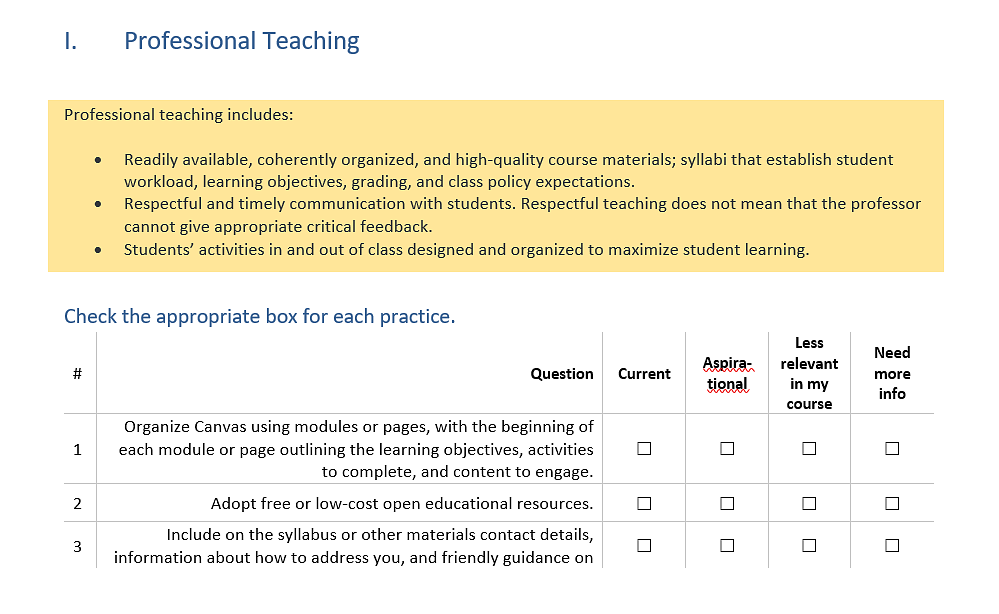The University of Oregon defines good teaching as professional, inclusive, engaged, and research-informed (PIER). The University of Oregon Teaching Practices Inventory* is designed to help instructors make sense of those categories in their own disciplinary contexts and bring them to life in their teaching. You might use it:
- as a tool for reflection about your teaching,
- as a source of evidence in peer review of teaching,
- to inform unit-level conversations about teaching in your discipline.
The inventory characterizes the PIERs categories and lists example practices for them, with the twin goals of clarifying what each of the four categories really means and providing ideas for how instructors might demonstrate them. Then the survey invites the user to identify practices they already use, aspire to adopt, would like to learn more about, or that are less relevant for their course context. It is important to realize that the inventory does not present comprehensive lists of all the practices that could be considered professional, inclusive, engaged, and research-informed. Therefore, the user can also highlight additional practices they use that fit into each of the four categories. Conversely, no instructor is expected or even advised to use all the practices listed in the inventory.
TEP offers two versions of the UO Teaching Practices Inventory designed for different purposes. The first is a Word document with checkable boxes--shown in the figure at right--that instructors can easily work with, save, and share. The second is a Qualtrics survey ideal for collection and analysis of data from larger groups.
How You Might Use the UO Teaching Practices Inventory
It is important for every instructor to reflect on their current teaching practices, learn about new possibilities, and identify new things to try. Such reflection is necessary for improvement and is a vital part of engaged teaching. To use the tool for this kind of reflection, we recommend that you download the Word version of the inventory, read the definition of each pillar, then go through the listed practices to see which ones you’re already using, pick out new ones to try, and create a list of practices you want to learn more about. Feel free to skip practices that don’t feel right for you or that you don’t have capacity for; nobody is expected to employ all of the strategies. The reflective process and completed inventory can serve as:
- A starting point for planning changes you want to make in your teaching.
- A point of reference when you want to check on your progress.
- A source of information to draw on when completing the self-presentation documents associated with teaching evaluation.
The Teaching Practices Inventory can be used as a source of information and evidence in the peer review of teaching. First, the reviewee fills out the inventory. Then the reviewer can use the completed document as a source of information about practices they might see (and look for) when reviewing the course. It can also serve as a window into the reviewee’s engaged teaching practices, which the reviewer is required to address in the review. When the reviewee completes the inventory, we suggest that they consider only the practices they employ in the course under review, even though they may employ different practices in other courses. The exception to this is the Engaged Teaching: Teaching Leadership section of the inventory, which is not related to a specific course. We recommend using the Word version of the inventory for peer review.
If all faculty in a unit complete the UO Teaching Practices Inventory, the collective results may be used to ground unit-level conversations about teaching policy, for example the discussions needed to develop the unit’s Teaching Evaluation Rubric. In addition to the standard questions, the version of the inventory we recommend for this purpose invites faculty to give their ideas about other practices they feel are important in the discipline. TEP can administer a Qualtrics version of the inventory tailored for unit-level use, keeping individual instructors' responses confidential. We will return results that provide a collective picture of practices faculty are already using, want to use, or otherwise think important for teaching in the discipline, as well as practices they feel don’t fit their courses. Alternatively, we can share the survey with you so your unit can administer it, making sure it's clear to faculty who might see their individual responses.
*Note that the UO Teaching Practices Inventory is distinct from the Carl Weiman Science Education Initiative’s Teaching Practices Inventory, a published, validated tool used by some units at UO.

